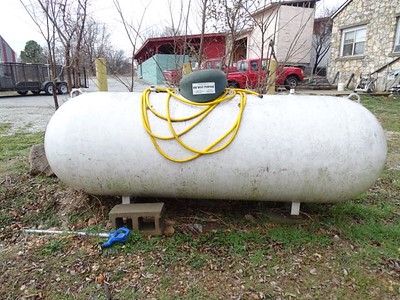How Big is a 250 Gallon Propane Tank (Will It Fit on Yard)


The common question we received from our readers is how big a 250-gallon propane tank tank and whether will it fit in the space limited in the yard. We will try to give you an insight about this topic.
A 250-gallon propane tank is a large tank that is typically used for residential and commercial purposes. The tank is typically around 8 feet long and 4 feet tall, and it has a cylindrical shape with 36 inches in diameter. This size of the tank is capable of holding around 200 gallons of propane (80% of its capacity), which is enough to power a large home or a small commercial building for an extended period of time.
It is typically made of steel or aluminum and is designed to withstand the elements and the pressure of the propane inside. The tank is also equipped with safety features such as a relief valve and a gauge that allows you to monitor the level of propane in the tank.
One of the main benefits of using a propane tank of this size and capacity is that it is able to hold a large amount of fuel, which means that it does not need to be refilled as often as smaller tanks. This can be especially beneficial for homes and businesses that use propane as their primary source of energy.
Another benefit of using this size tank is that it is relatively easy to install and maintain. The tank can be placed above or below ground, and it is typically connected to the rest of the propane system using a series of pipes and valves.
In terms of cost, the 250 gallon propane tank can be more expensive than smaller tanks, but the cost is often offset by the fact that it does not need to be refilled as often. Additionally, depending on the location and the specific tank, there may be rental options that can be more cost-effective for some users.
This capacity tank is a large and efficient fuel storage solution that is well-suited for homes, businesses, and other commercial or industrial applications. With its large storage capacity, easy maintenance, and relatively low costs, it is an excellent choice for anyone looking to power their home or business with propane.
How Much Does a 250 Gallon Propane Tank Weigh
The weight of a 250 gallon propane tank can vary depending on the specific tank and its manufacturer. However, on average, an empty tank weighs around 500-600 pounds, and when filled with propane, it can weigh around 1700 pounds. It’s important to keep in mind that a filled tank is extremely heavy and should be handled with proper equipment and safety precautions.
It’s always recommended to check with the manufacturer or supplier for the specific weight of the tank you are interested in. This information may also be listed on the product specification or the instruction manual that comes with the tank.
Will This Size of Propane Tank Fit in My Yard
A 250-gallon propane tank will fit in most backyards, but there are a few things to consider before installation. First, measure the dimensions of your yard and compare them to the dimensions of the propane tank. The tank should be able to fit comfortably in the space with room to spare.
Secondly, consider the weight of the tank when full. It is important to make sure that your yard can support the weight of the tank and that it is level. If you have any concerns, consult with a professional before proceeding with installation.
Amount of Propane a 250 Gallon Tank Can Hold
A 250-gallon tank can hold a little over 200 gallons of propane. This is because the tank is only 80% full when it’s full of propane. The other 20% is left empty for expansion of the liquid propane.
Physical Characteristics
As a homeowner, it’s important to know the physical characteristics of your 250-gallon propane tank. Here are the characteristics of this size of propane tank:
The Size of the Tank
A 250-gallon propane tank is about four feet tall and wide and holds about 200 gallons of propane. It is a safe choice for most homes that use propane as their main source of energy.
The Shape of the tank
Most 250-gallon propane tanks are either cylindrical or spherical in shape. The dimensions of a cylindrical tank are typically (height) x (width) x (length), while the dimensions of a spherical tank are typically (diameter) x (height). The capacity of a propane tank is usually measured in gallons, but can also be expressed in pounds or cubic feet.
Material of this size of propane tank
The 250-gallon propane tank is made of high-quality materials that can withstand high temperatures and pressures. The tank is made of thick, durable steel that can withstand the elements and the weight of the propane. The tank has a thick, corrosion-resistant coating that protects it from the elements and keeps it looking new. The tank also has a safety valve that prevents the propane from leaking out.
Safety features
When it comes to propane tanks, safety is always a top priority. That’s why these tanks are equipped with a number of safety features, including:
- A pressure relief valve that releases pressure if the tank gets too hot
- A secondary shut-off valve that stops the flow of propane if the primary valve fails
- A fireproof shell that protects the tank from external fires- An overfill prevention device that shuts off the flow of propane when the tank is full
These safety features make these tanks one of the safest ways to store and use propane.
How Long Does It Last
- Understanding Propane Energy Content:
- Propane’s energy is typically measured in British Thermal Units (BTUs).
- One gallon of propane contains approximately 91,500 BTUs.
- Therefore, a 250-gallon tank holds about 22,875,000 BTUs in total.
- Practical Energy Usage Examples:
- This energy can be equated to various everyday uses. For instance, a standard home furnace might consume 50,000 to 150,000 BTUs per hour.
- In cooking, a medium-sized grill uses about 30,000 BTUs per hour.
- These examples help visualize how much energy a 250-gallon tank contains and how it can be utilized in a household.
Average Duration the Tank Will Last for Various Uses
- Home Heating:
- Assuming a furnace consumes 100,000 BTUs per hour, the tank could theoretically provide 228 hours of continuous heating.
- This translates to about 30 days of heating if run 8 hours per day.
- Cooking:
- If a grill uses 30,000 BTUs per hour, the tank could support approximately 762 hours of grilling.
- For an average family grilling 1 hour per day, this could last over 2 years.
- Water Heating:
- Water heaters typically use around 40,000 BTUs per hour. The tank could last for about 572 hours of operation.
- For a family using 2 hours of hot water per day, this equates to approximately 9 months.
Factors Affecting Propane Consumption Rate
- Appliance Efficiency:
- More efficient appliances consume less propane for the same output, extending the duration of the tank.
- Usage Frequency and Duration:
- The more frequently and longer propane-consuming appliances are used, the faster the tank will deplete.
- Seasonal Variations:
- In colder months, heating needs increase, leading to higher propane consumption.
- Conversely, in warmer months, usage may decrease, prolonging the life of the tank.
- Temperature Settings:
- Higher temperature settings on heaters or water heaters will consume more propane.
- Household Size and Lifestyle:
- Larger families or households with higher usage patterns (e.g., frequent cooking, guest hosting) will use more propane.
- Maintenance of Appliances:
- Poorly maintained appliances may be less efficient, leading to increased propane use.
Understanding these factors can help users estimate how long a 250-gallon propane tank will last in their specific context, aiding in better planning and management of their propane supply.
Placement Options for a 250-Gallon Propane Tank
A 250-gallon propane tank can be placed above ground, underground, or semi-underground.
Above-ground tanks are the most common type of propane tank. They are less expensive than underground or semi-underground tanks, and they are easier to install. Above-ground tanks can be installed on a concrete pad or on metal supports.
Underground tanks are more expensive than above-ground tanks, but they have several advantages. First, they are out of sight, so they don’t detract from the appearance of your property. Second, they are more protected from the elements, so they last longer. Third, if you leak an underground tank, the environment is less likely to be contaminated.
Semi-underground tanks offer the best of both worlds: they are less expensive than underground tanks and more protected from the elements than above-ground tanks. Semi-underground tanks must be installed on a concrete pad with metal supports.
To Make a Conclusion
It’s important to know the dimensions of the propane tank you’re considering before purchasing this size of tank or attempting to install it on your property.
This size of tank is quite large, and it requires a significant amount of space to be placed. It’s important to consider the space availability in your yard before deciding on a 250 gallon propane tank.
It’s also important to consider the local codes and regulations regarding propane tank placement, as there may be specific requirements for the distance between the tank and structures or property lines. It’s highly recommended to check with your local authorities, as well as with the manufacturer or supplier regarding the tank’s dimensions before installing it.
In addition to space, you will also need to consider the accessibility to the tank for maintenance, as well as the aesthetic impact on your property. It’s advisable to have a clear plan in mind and measure your space before making a decision.
Finally, it’s important to consider the weight of the tank when it’s full, which can be around 1,700 pounds, and it will require the use of proper equipment for handling and installing it.

Mike is an experienced propane technician with over 15 years of professional experience in the field. He has dedicated his career to helping customers with their propane needs, from installation to maintenance and repair. Together with Jeremy, he co-founded this website to provide useful information and guidance to customers seeking reliable propane services.
Mike is an experienced propane technician with over 15 years of professional experience in the field. He has dedicated his career to helping customers with their propane needs, from installation to maintenance and repair. Together with Jeremy, he co-founded this website to provide useful information and guidance to customers seeking reliable propane services.
View All Articles
